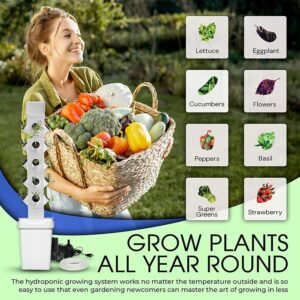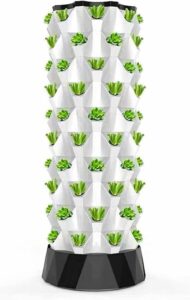From Seed to Harvest: Optimizing Growth with a DIY Vertical Hydroponic Garden
Introduction
Hydroponics has gained significant popularity in modern gardening due to its ability to maximize plant growth and optimize space utilization.
Among the various forms of hydroponic systems, the DIY vertical hydroponic garden stands out as a space-efficient and productive option.
This article will help you through the process of creating and maintaining a DIY vertical hydroponic garden, from seed to harvest.
By following these steps, you can harness the benefits of this innovative gardening method and achieve optimal growth for your plants.
Provo Green Products is your reliable source for discovering sustainable products that can positively impact your life and the environment.
With extensive experience in manufacturing, trades, and construction, Provo Green Products thoroughly researches each product before providing accurate and up-to-date information on its sustainability.
You can trust that you’re getting trustworthy insights to make informed choices whether you’re looking for solar products, electric bikes, eco-friendly products, renewable energy solutions, etc.
Provo Green Products is your go-to destination for finding the right green products for your lifestyle.
Disclosure: We may earn a small commission if you click on one of our links.
This does not affect the pricing of the product whatsoever.
Understanding Hydroponics
Before diving into the specifics of vertical hydroponic gardening, let’s briefly explore the concept of hydroponics itself.
Hydroponics is a soilless cultivation method that involves growing plants in a nutrient-rich water solution, providing all the essential elements needed for growth.
This method eliminates the need for traditional soil-based gardening and allows plants to access nutrients more efficiently.
Vertical hydroponic systems take this concept a step further by utilizing vertical space.
Vertical gardens optimize space utilization by arranging plants in stacked layers, making them ideal for small gardens, balconies, or indoor cultivation.
Planning Your Vertical Hydroponic Garden
To embark on your vertical hydroponic gardening journey, it’s crucial to start with proper planning.
Begin by selecting an appropriate location for your garden.
Consider factors such as sunlight exposure, accessibility, and proximity to a water source.
Once you have chosen a location, determine the size and capacity of your system based on the available space and the number of plants you intend to grow.
Also, choose plants suitable for vertical cultivation, such as leafy greens, herbs, strawberries, or compact fruiting varieties.

Building a DIY Vertical Hydroponic Garden
Constructing your own vertical hydroponic garden can be a rewarding and cost-effective endeavor.
Begin by gathering the necessary materials and tools, including PVC pipes, growing containers, a water pump, and a nutrient reservoir.
Follow these step-by-step instructions to build your garden structure:
- Assemble the PVC framework: Cut the PVC pipes into appropriate lengths and connect them to form the frame of your vertical garden. Ensure stability and proper alignment.
- Install the growing containers: Attach the growing containers, such as net pots or buckets, to the PVC pipes at regular intervals. These containers will hold the plants and their root systems.
- Set up the water pump and nutrient reservoir: Install and connect a water pump to a nutrient reservoir. This pump will circulate the nutrient solution through the system, providing essential nutrients to the plants.
- Configure the water delivery system: Create a tube or channel network that distributes the nutrient solution to each growing container. Ensure even water flow and proper drainage.
- Test the system: Before introducing plants, thoroughly test your hydroponic system to ensure proper water circulation, nutrient delivery, and drainage. Make any necessary adjustments or repairs.
Selecting Seeds and Germination Techniques
Choosing the right seeds and employing effective germination techniques are crucial for successful vertical hydroponic gardening.
Select seeds that are known to thrive in hydroponic systems, such as lettuce, spinach, or basil.
Follow these steps for optimal germination:
- Pre-soak the seeds: Some seeds benefit from pre-soaking to stimulate germination. Place the seeds in water for a specified duration, as the seed supplier recommends.
- Use a germination medium: Opt for a suitable germination medium, such as rock wool cubes or oasis cubes. These provide a stable environment for seedlings to develop.
- Maintain proper moisture and temperature: Keep the germination medium moist but not overly saturated. Maintain the recommended temperature range to facilitate germination.
Nutrient Solution Management
Maintaining a well-balanced nutrient solution is essential for optimizing growth in your DIY vertical hydroponic garden.
Here are some key aspects of nutrient solution management:
- Understanding nutrient requirements: Different plants have varying nutrient requirements at different stages of growth. Familiarize yourself with the specific nutrient needs of the plants you are growing and adjust your solution accordingly. Common essential nutrients include nitrogen, phosphorus, potassium, calcium, magnesium, and trace elements.
- Mixing the nutrient solution: Follow the instructions provided by your hydroponic nutrient solution manufacturer. Generally, you will need to dilute the concentrated solution with water to achieve the desired nutrient strength. Use a pH meter to monitor and adjust the pH level of the solution, aiming for a range suitable for the specific plants you are cultivating.
- Monitoring and adjusting nutrient levels: Regularly test the nutrient solution using an electrical conductivity (EC) meter to measure its total dissolved solids (TDS). This will help you ensure the nutrient levels are within the appropriate range for optimal plant growth. Adjust the nutrient solution by adding more water or concentrated solution as needed.
- Flushing and replacing the nutrient solution: Over time, the nutrient solution can become depleted or imbalanced. It is important to periodically flush the system and replace the nutrient solution to maintain healthy plant growth. The frequency of flushing depends on the specific plants and their growth stage. As a general guideline, flushing and replacing the solution every two to three weeks is recommended.

Providing Adequate Lighting
Proper lighting is crucial for photosynthesis and overall plant growth in your vertical hydroponic garden.
Since plants in a vertical system may receive less natural sunlight, it is important to provide adequate artificial lighting.
Consider the following:
- Selecting appropriate grow lights: LED (Light Emitting Diode) grow lights are highly recommended for vertical hydroponic gardens. They are energy-efficient, emit the specific wavelengths of light required for photosynthesis, and produce less heat. Choose lights with a spectrum that matches the needs of the plants you are growing.
- Placement and duration of lighting: Position the grow lights at an appropriate distance from the plants to ensure proper coverage and avoid light burn. The recommended distance may vary depending on the specific light and plant species, so refer to the manufacturer’s guidelines. Provide the plants with a sufficient daily light duration based on their requirements, typically ranging from 12 to 16 hours.
- Supplementing natural light: If your vertical garden is located in an area with limited natural sunlight, you may need to supplement the available light with artificial lighting. Use a combination of natural and artificial light to provide optimal lighting conditions for your plants.
Maintaining Environmental Conditions
Creating and maintaining suitable environmental conditions is crucial for the success of your DIY vertical hydroponic garden.
Consider the following factors:
- Temperature and humidity control: Maintain appropriate temperature and humidity levels within the growing area. Most plants thrive in temperatures between 65°F (18°C) and 75°F (24°C) during the day and slightly cooler temperatures at night. Humidity levels should be between 50% and 70% for optimal growth. Use fans or ventilation systems to circulate air and control humidity.
- Air circulation and ventilation: Proper air circulation helps prevent the buildup of stagnant air, reduces the risk of diseases, and promotes healthy plant growth. Use fans or natural airflow to ensure adequate ventilation within the growing area. This is particularly important in indoor or enclosed spaces.
- Pest and disease prevention: Vertical hydroponic gardens are less susceptible to certain pests and diseases than traditional soil-based gardens. However, it is still important to regularly inspect your plants for signs of pests or diseases. Implement preventive measures such as maintaining cleanliness, using organic pest control methods, and practicing good hygiene to minimize the risk of infestations.

Monitoring Plant Growth and Maintenance
Regular monitoring and maintenance are essential to ensure your plants’ optimal growth and health in a DIY vertical hydroponic garden.
Here are some key steps to follow:
- Tracking plant growth milestones: Keep a record of important growth milestones, such as germination, transplanting, and flowering. This will help you monitor the progress of your plants and identify any issues that may arise.
- Routine maintenance tasks: Regularly inspect your plants for any signs of nutrient deficiencies, pest infestations, or diseases. Trim or prune plants as necessary to maintain their shape and prevent overcrowding. Additionally, provide support such as trellises or stakes for plants that require it.
- Nutrient solution monitoring: Continuously monitor the pH and nutrient levels of the solution to ensure they remain within the appropriate range. Adjust the pH and nutrient strength as needed based on the specific requirements of your plants.
- Troubleshooting common growth issues: Familiarize yourself with common growth issues in hydroponic systems, such as nutrient deficiencies, root rot, or algae growth. Learn to identify the symptoms and take appropriate corrective measures, such as adjusting nutrient levels or improving aeration.
Harvesting and Enjoying the Fruits of Your Labor
The ultimate reward of your DIY vertical hydroponic garden is the bountiful harvest.
Follow these steps to ensure a successful and satisfying harvest:
- Timing the harvest: Each plant has its own optimal harvesting time, which is usually indicated by visible cues such as fruit color, size, or firmness. Refer to plant-specific guidelines or consult reputable gardening resources to determine the ideal harvest time for each crop.
- Harvesting techniques: Use clean, sharp tools to harvest your crops, ensuring minimal damage to the plants. Gently remove mature fruits or cut leafy greens at the base. Be mindful not to disturb the roots or other nearby plants.
- Post-harvest handling: Handle harvested produce with care to maintain freshness and quality. Clean vegetables or fruits thoroughly, removing any dirt or debris. Properly store them in appropriate containers or refrigeration, following specific recommendations for each crop.
- Celebrating the rewards: Enjoy the fruits of your labor by incorporating fresh, homegrown produce into your meals. Share your harvest with friends and family, and take pride in the sustainable, nutritious food you have cultivated in your DIY vertical hydroponic garden.
Conclusion
By embarking on the journey of creating a DIY vertical hydroponic garden, you are embracing a sustainable and space-efficient method of cultivating plants.
From seed to harvest, optimizing growth in your vertical hydroponic garden requires careful planning, proper construction, nutrient management, lighting considerations, environmental control, and diligent monitoring.
With patience, dedication, and a bit of green-thumb enthusiasm, you will experience the joys of bountiful harvests and the satisfaction of successfully optimizing growth in your DIY vertical hydroponic garden.
Stay in Touch!
I’am a dedicated entrepreneur with many years of experience and an integrity-driven individual who is highly motivated to succeed. Leveraging extensive expertise in manufacturing, construction, and various trades, we can provide a solid foundation for sustainable living. Our meticulous research process guarantees that our information about each product is precise and current, allowing you to make informed decisions. A deep understanding of business operations empowers me to consistently implement improvements that result in ongoing success. Visit site.
